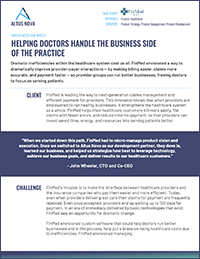Fintech
Healthtech
Helping doctors handle the business side of the practice
Dramatic inefficiencies within the healthcare system cost us all. FinMed envisioned a way to dramatically improve provider-payer interactions — by making billing easier, claims more accurate, and payment faster — so provider groups can run better businesses, freeing doctors to focus on serving patients.
Client
FinMed is leading the way to next-generation claims management and efficient payment for providers. This innovator knows that when providers are empowered to run healthy businesses, it strengthens the healthcare system as a whole. FinMed helps their healthcare customers bill more easily, file claims with fewer errors, and reduce time-to-payment, so that providers can invest saved time, energy, and resources into serving patients better.
When we started down this path, FinMed had to micro-manage product vision and execution. Once we switched to Altus Nova as our development partner, they dove in, learned our business, and helped us strategize how best to leverage technology, achieve our business goals, and deliver results to our healthcare customers.”
Challenge
FinMed’s mission is to make the interface between healthcare providers and the insurance companies who pay them easier and more efficient. Today, even when providers deliver great care their claims for payment are frequently rejected. Even once accepted, providers end up waiting up to 120 days for payment. In an era of immediacy delivered by basic technologies that exist, FinMed saw an opportunity for dramatic change.FinMed envisioned custom software that could help doctors run better businesses and in the process, help put a brake on rising healthcare costs due to inefficiencies. FinMed envisioned managing:
- Quality control. FinMed helps customers catch more errors before claims are submitted, while simplifying error presentation so billing teams can understand how to file claims more accurately. FinMed also wanted to help customers move faster by correcting many errors in-flight without further action by billing staff.
- Targeted training. FinMed customers can improve the business side of their practices with customized training and best practices. By teaching billing staff to correct the most common and impactful claims issues the practice faces, dramatic improvements in claim acceptance rate and payment processing time can be achieved.
- Faster cashflow. The company’s “Pay Forward” cashflow management capabilities enable FinMed to pay each provider up to 60% of Medicare-approved claim values at the time of submission. This saves FinMed customers 60 to 90 days of processing time and improves cash flow with each claim they file.
FinMed’s founders have more than 100 years of combined healthcare experience and a compelling digital product vision. But after working to develop the product for over a year with no results, FinMed realized they needed to find a new product development partner. They chose Altus Nova for their proven ability to deliver strategic breakthroughs along with impeccable development quality, and got underway.
Discovery
To pick up where the previous team left off, Altus Nova needed to deeply understand FinMed’s vision and business goals, and to examine each aspect of the business problem. We examined:
- EHR formats. Analyzing the formats of claims generated by the most popular Electronic Health Record (EHR) systems allowed us to define a data processing pipeline that could ingest and analyze provider claims.
- Integration mechanisms. Understanding how provider groups could integrate with FinMed’s solution — whether via API integration, secure FTP sites, manual file uploads, and more — helped that would be used by each Healthcare Provider Group when integrating with FinMed’s solution.
- Common errors. Assessing the type and range of issues claims exhibit helped us to define a straightforward mechanism to translate errors into a user-friendly format that could benefit billing staff as they worked.
With a clear map of the problem, Altus Nova rapidly assessed FinMed’s existing technology infrastructure to identify what could be salvaged and built upon, what needed re-working, and what would need to be developed from scratch — all without missing the aggressive deadline that FinMed was already up against.

